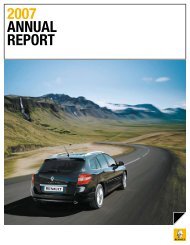2007 Interactive Registration Document - Renault
2007 Interactive Registration Document - Renault
2007 Interactive Registration Document - Renault
You also want an ePaper? Increase the reach of your titles
YUMPU automatically turns print PDFs into web optimized ePapers that Google loves.
01 THE<br />
RENAULT AND THE GROUP<br />
RENAULT-NISSAN ALLIANCE<br />
CROSS-COMPANY TEAMS (CCTs )<br />
The CCTs are working groups comprising staff and experts from both companies<br />
that are tasked with exploring possible areas of cooperation and synergy<br />
between <strong>Renault</strong> and Nissan, defi ning and concretely specifying projects<br />
and then monitoring the implementation of projects approved by the Board.<br />
There are 10 teams working in the following areas:<br />
1. Product Planning 6. Process Engineering<br />
2. Light Commercial Vehicles 7. Manufacturing<br />
3. Research & Advanced Engineering 8. Logistics<br />
4. Vehicle Engineering 9. Parts and Accessories<br />
5. Powertrains 10. Purchasing<br />
The CCTs are headed by two co-leaders, one from <strong>Renault</strong> and one from<br />
Nissan.<br />
The 10 CCTs report to the Alliance Board on the state of progress of their work<br />
and their results through the Steering Committees.<br />
FUNCTIONAL TASK TEAMS (FTTs )<br />
The FTTs are made up of experts from both <strong>Renault</strong> and Nissan and provide the<br />
CCTs with essential support in terms of benchmarking, the promotion of best<br />
practices and the harmonization of tools used in the support functions.<br />
1.3.3 THE STATUS OF ALLIANCE PROJECTS<br />
Since the Alliance agreement was signed in 1999, <strong>Renault</strong> and Nissan have<br />
initiated cooperation programs in a broad range of fi elds of activity. The synergies<br />
generated can be classifi ed into two categories:<br />
n<br />
n<br />
structural cooperation;<br />
regional cooperation.<br />
1.3.3.1 STRUCTURAL COOPERATION<br />
VEHICLE ENGINEERING<br />
The sharing of platform or engineering architecture and, more signifi cantly, the<br />
sharing of major components have been a key element of the Alliance’s success.<br />
The partners can develop this sharing as they renew their line-ups.<br />
B and C Platforms<br />
An initial common platform (a Nissan-led project), the B platform, has been used<br />
by Nissan since 2002 with the new March (Micra in Europe) and Cube. This<br />
was followed in 2004 by the launch of the Tiida and Tiida Latio in the Japanese<br />
domestic market and the Nissan Note launched in January 2005. Tiida has<br />
< TABLE OF CONTENTS ><br />
There are 11 FTTs that continue to cover the following key areas:<br />
1. Corporate Planning 7. Marketing<br />
2. Product Engineering Performance 8. Sales & Service<br />
3. Quality 9. Legal & Intellectual Property<br />
4. Industrial Strategy 10. Communications<br />
5. Cost Management & Control<br />
6. Customs, Trade & Global Tax<br />
11. Human Resources<br />
TASK TEAMS (TTs )<br />
As soon as a specifi c issue is identifi ed, a Task Team (TT) is appointed to work<br />
on the issue within a certain timeframe.<br />
There are currently 12 TTs working on the following topics:<br />
1. Europe 7. Korea<br />
2. Eastern Europe 8. Africa & Middle East<br />
3. Maghreb 9. Mexico<br />
4. China 10. Mercosur<br />
5. ASEAN 11. Business to Employee<br />
6. Asia/Oceania 12. New Market Standards<br />
subsequently gone on sale in selected global markets, including the US where<br />
it is sold as the Versa. Two additional vehicles, the Nissan Wingroad (launched in<br />
November 2005) and the Nissan Bluebird Sylphy (launched in December 2005),<br />
are also based on the B platform.<br />
On May 19, 2004, <strong>Renault</strong> unveiled a new model, Modus, its fi rst vehicle to<br />
use the common B platform. It was marketed mainly in Europe from September<br />
of the same year. In September 2005, <strong>Renault</strong> launched Clio III, also built on<br />
this platform.<br />
The Logan, initially marketed under the Dacia and <strong>Renault</strong> brands, but to<br />
be sold as a Nissan in certain markets and as a Mahindra <strong>Renault</strong> in India,<br />
was launched in September 2004. The Logan is based on a derivative of the<br />
common B platform.<br />
A second common platform (a <strong>Renault</strong>-led project), the C platform,<br />
was launched by <strong>Renault</strong> at end-2002 for production of its new Mégane II.<br />
In December 2004, the Lafesta, a new minivan, was launched in Japan as the<br />
fi rst model in Nissan to adopt the common C platform. Nissan launched the<br />
new Serena minivan in May 2005, and the new Nissan Sentra in October 2006<br />
in the United States; both vehicles are also based on this platform. In <strong>2007</strong>,<br />
the Nissan Qashqai (Dualis in Japan and Australia) and <strong>Renault</strong> Samsung<br />
QM5 were launched, based on the same platform.<br />
30 <strong>Registration</strong> <strong>Document</strong> <strong>Renault</strong> <strong>2007</strong><br />
Find out more at www.renault.com<br />
01<br />
02<br />
03<br />
04<br />
05<br />
06<br />
07<br />
08




